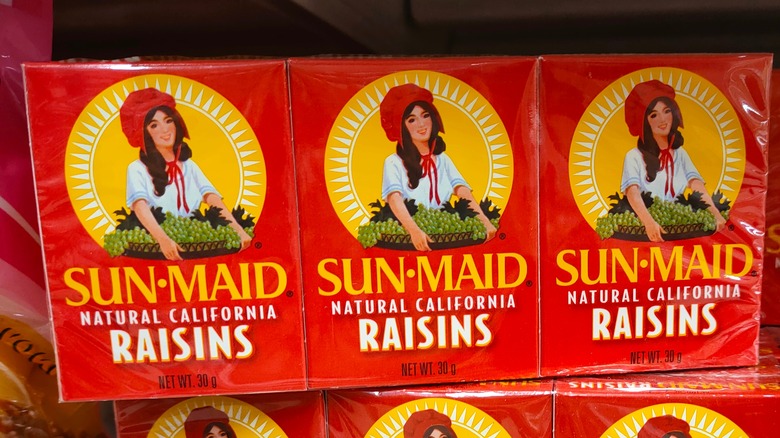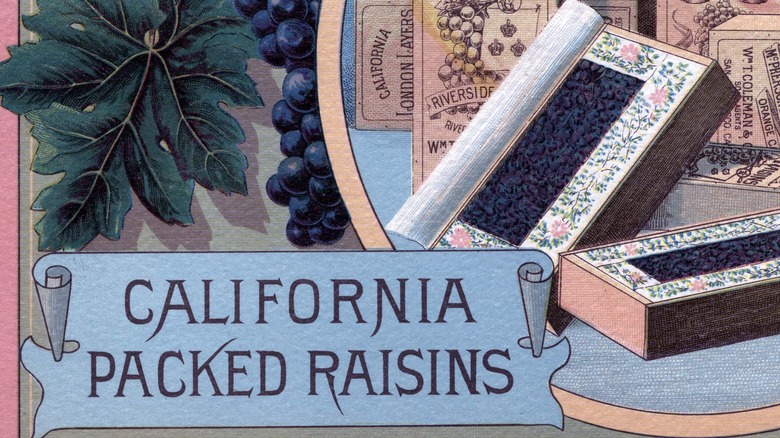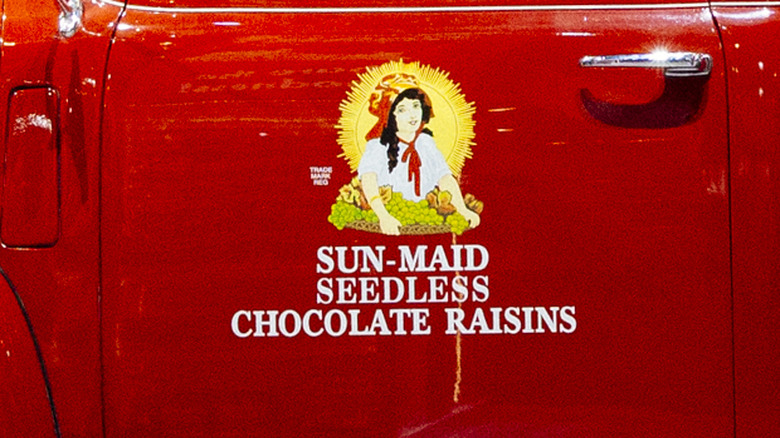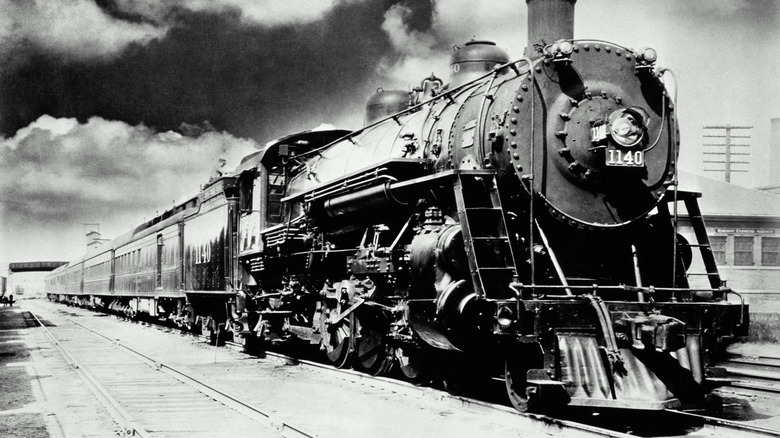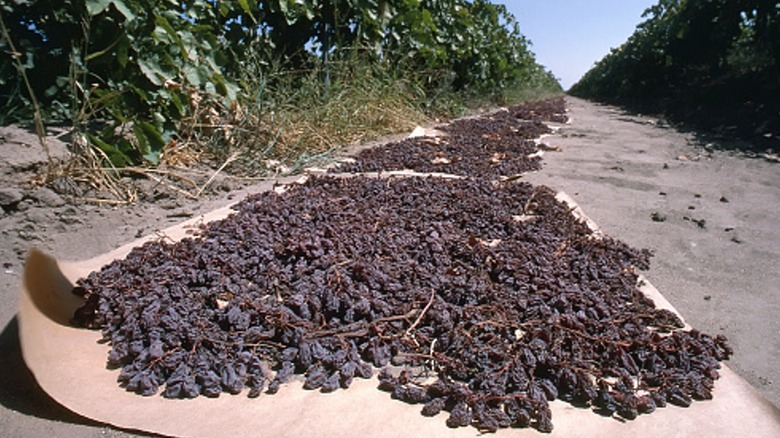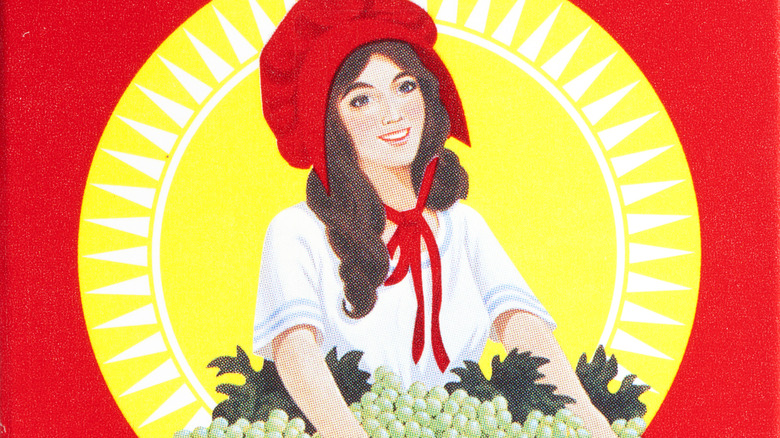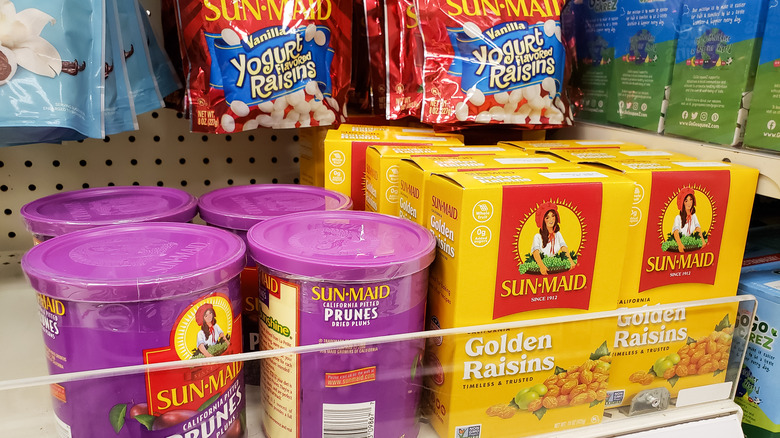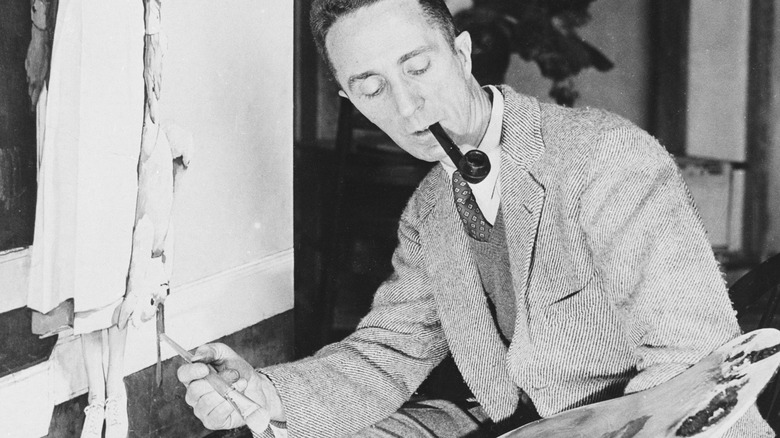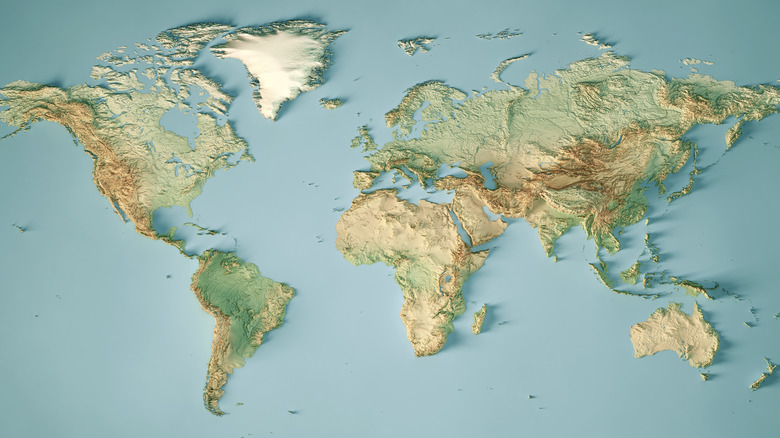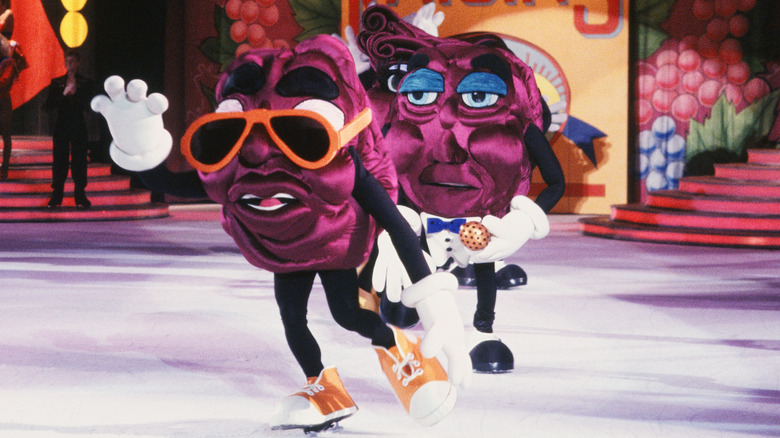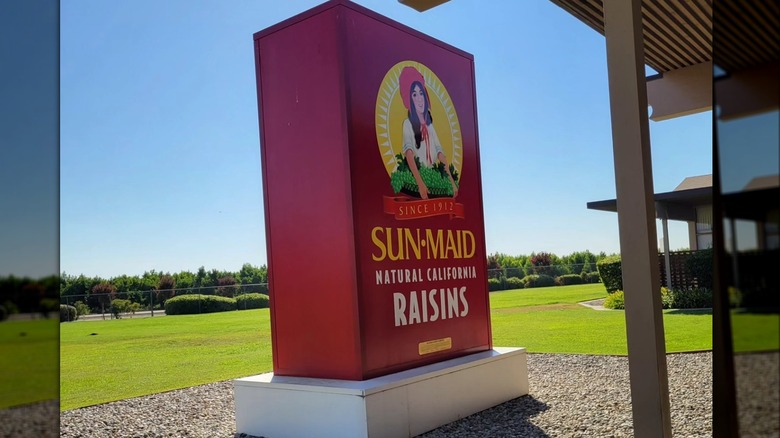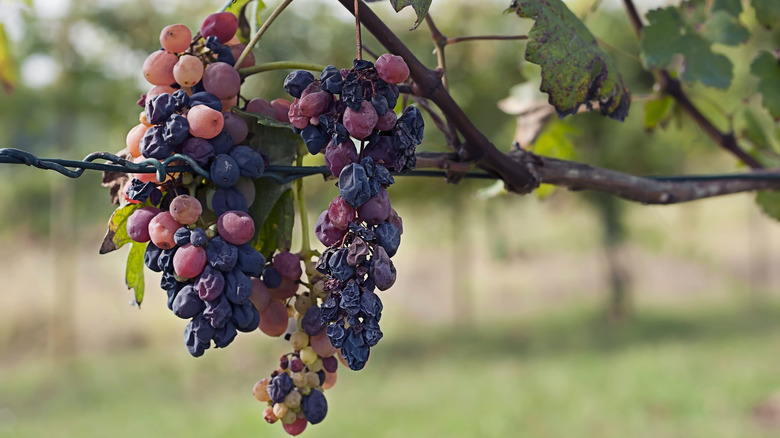Sun-Maid Raisins: Facts About The Dried Fruit Pantry Staple
Certain companies are so synonymous with a particular item — think Band-Aids and adhesive bandages or cotton swabs and Q-Tips — that it's downright startling to discover those famous brands are not the only purveyors of said product. In that vein, it may be impossible to overstate the sheer dominance of Sun-Maid in the raisin industry ... but that doesn't mean the California-based co-op holds a genuine monopoly on all things raisin-related.
Of course, even if the Sun-Maid Raisin brand (not to be confused with Raisin Bran) isn't the sole producer of dried grape products in the U.S., its modern status as the best known name in that field is unquestioned. Any fan of nature's candy is intimately familiar with the sweet, chewy delightfulness found in each and every miniature red box of Sun-Maid Raisins. Quite frankly, with a legacy that stretches back more than 100 years, Sun-Maid is on par with Green Giant or Yuengling as a true titan of the American food industry.
With that in mind (and a fairly fascinating, century-plus back story to boot), we decided to shine a light on Sun-Maid Raisins and the company's long-running history. If you're well-acquainted with the indisputably glorious (and stunningly consistent) flavor profile of Sun-Maid Raisins but would like to know more about the brand behind the healthy snack, keep reading as we reveal some interesting facts about this dried fruit pantry staple.
Sun-Maid is owned by a co-op comprised of California raisin growers
Though the term may be unfamiliar to those outside the business world, a cooperative ownership model is rather simple to understand. After all, a co-op is little more than a business arrangement where a number of individual members share ownership (in lieu of a singular owner). Long story short, Sun-Maid Raisins is actually a co-op made up of California-based raisin growers.
Originally consisting of "raisins grown by 6,000 California growers" — as the brand famously advertised during its early years — Sun-Maid doesn't appear to have quite as many individually operated raisin farmers among its ownership in the 21st century. But with hundreds of member-farms — and contributions from hundreds of additional, non-owner raisin growers as well — it's clear the Sun-Maid business hasn't strayed far from its initial formation as the California Associated Raisin Company.
Of course, at the end of the day? It hardly matters who, precisely, owns Sun-Maid Raisins. As long as it continues cranking out little red boxes filled with delectable raisins (each one adorned with the bright, magnetic image of the Sun-Maid Raisins girl), we'll continue to stock our pantry with its product.
A 1912 handshake agreement among California farmers led to Sun-Maid's founding
There's a reason why the vast majority of legally binding contractual agreements consist of hard copies (which can be reviewed and signed by all interested parties). After all, there's nothing binding a person or company — legally speaking, we mean — to any sort of deal unless there's an actual, signed agreement involved. In that regard, it's sort of stunning to learn the company that would eventually become Sun-Maid Raisins apparently began after little more than a handshake.
Now, we're sure the group of San Joaquin Valley-based raisin growers who first founded the California Associated Raisin Company in 1912 didn't actually rely on mere handshakes when creating their co-op. But it's clear the group of central California raisin farmers shared a strong commitment, and willingness to work together for the greater good, upon joining forces.
Hence, none of the raisin growers appeared to renege on their word to join the co-op after the initial agreement. And once H.H. Welsh was officially named the California Associated Raisin Company's first chairman, there was no turning back. And the rest is history.
The Sun-Maid name was the brainchild of a California-based advertiser
It's clear by now (at least, it is to anyone who has been paying attention) that the Sun-Maid Raisins company didn't begin its tenure under that universally famous moniker. In fact, while thousands of California raisin growers initially began working together as the California Associated Raisin Company in 1912, the company's current name didn't exist until 1914 — when a local advertiser named E.A. Berg transformed a co-op slogan into the simple but effective Sun-Maid label.
To be perfectly honest, we're not entirely sure what prompted Berg to tweak the spelling of "made" when devising the raisin brand's now-ubiquitous name. We might have speculated the decision to instead use the homophone "maid" was related to the company's incredibly famous mascot (and her relatively maid-like appearance). But seeing how the Sun-Maid Raisins girl (modeled after Lorraine Collett) wasn't introduced until 1915, it's clear the name is wholly unrelated to the company's mascot.
Whatever the explanation, Berg's marketing idea worked like gangbusters in the short and long run (although we'd be amazed if the man could have predicted just how famous his Sun-Maid name would eventually become).
Sun-Maid had one of the first nationwide advertising campaigns via a 2,000-mile train ride
Sun-Maid is easily known from sea to shining sea in the 21st century. Yet it wasn't always that way — particularly when it first started out in the 1910s as the California Associated Raisin Company. So in a world where the internet, television, and radio didn't yet exist, the not-yet-named Sun-Maid Raisins co-op made a nationwide splash early on the only way it knew how: by sending a train filled with 1,250 tons of raisins halfway across the country to celebrate (and advertise) its product.
Festooned with multiple banners reading "Raisins Grown by 6,000 California Growers," the 2,000-mile long marketing ploy was a huge success for the newly formed company. With 60 train cars containing a whopping $150,000 worth of raisins, according to the company's history, the event was described by The Fresno Morning Republican at the time as "the biggest single fruit shipment ever made from the state."
Companies may no longer need to rely on such gimmicky advertising techniques to market a product (at least not exclusively). Still, any business that's swung for the fences (so to speak) with any type of widespread marketing stunt appears to owe a debt of gratitude to the raisin co-op's early, pre-Sun-Maid advertising scheme.
Its raisins are grown and harvested in a number of ways
Whether or not you're familiar with the production process for industrial-made raisins (like those grown and sold by Sun-Maid), you're probably under the impression that the fruit-adjacent snack is made by drying fresh-grown grapes in the sun. Now, to be sure, this is a technique used by a number of Sun-Maid raisin growers — but it's not the only one. In fact, while a large portion of Sun-Maid raisins are indeed made by placing grapes on paper and leaving them in the sun, some are actually dried while still on the vine.
Actually, the precise process used for harvesting grapes for raisins isn't entirely uniform, either. Some raisin vineyards are harvested manually through hand-picking, while others are harvested mechanically with farming equipment. Additionally, the exact manner in which grapes are grown for raisin production has evolved over the decades.
For example, the use of dried-on-the-vine production techniques didn't become common until the early 2000s. In that sense, it's difficult to predict the future when it comes to the growing and harvesting practices for commercial raisins — but we're eager to see (and taste) what's next.
The model for the Sun-Maid Raisins girl was discovered while drying her hair
The notion that a person can become famous by serendipitously being in the right place at the right time is a modern day fairy tale. Yet the existence of such individual fantasies are, in part, rooted in reality. Take, for instance, the story of Lorraine Collett — better known to the world as the original Sun-Maid Raisins Girl. After all, according to company legend, Collett was only discovered (and chosen to model as the mascot) after a Sun-Maid executive saw her drying her hair in her backyard with the famed red bonnet in 1915.
Now, despite the seeming happenstance of Collett's story, she had actually worked for Sun-Maid Raisins prior to her so-called discovery. Collett attended the 1915 Panama Pacific International Exposition in San Francisco, California, as one of several female representatives for the then-named California Associated Raisin Company ... where the women wore blue bonnets rather than red.
In fact, according to Collett herself, she wasn't even "seen by Sun-Maid executive Leroy Payne wearing my mother's red bonnet" until after her trip to the exposition. But once Payne noticed her — and the way the "red (bonnet) reflected the color of the sun better" — Collett was asked to model for a painting, leading to the iconic image still seen on every Sun-Maid package.
Sun-Maid's product line isn't limited solely to raisins
Considering the corporate footprint of Sun-Maid Raisins in the 21st century, it would be foolish to presume the company behind the internationally sold dried fruit pantry staple is limited to the sale of raisins. And the company has indeed expanded well beyond its initial focus of selling raisins (and nothing but raisins). As a matter of fact, as of August 2023, Sun-Maid has a number of additional dried fruit products for sale beyond its bread-and-butter staple in raisins.
Of course, it's not as though Sun-Maid only recently decided to expand its product line beyond dried grapes. The brand has been producing (or experimenting with) non-raisin items since the 1970s. During that decade, the company began selling dried apricots and dried prunes while also producing alcohols made with raisin by-products (if only we could purchase raisin-flavored Smirnoff at our local package store).
Obviously, though, you don't need to know the company's product-introduction history to recognize its current product lines beyond raisins. Sun-Maid continues to sell a variety of additional dried fruits in the 2020s as well as raisin bread to interested consumers.
Norman Rockwell contributed several paintings to be used in advertisements during the 1920s
The legacy of Norman Rockwell as an icon of American art is unquestionable. Of course, while the legendary painter of any and all things Americana may be most famous for his unrivaled collection of Saturday Evening Post cover paintings, his oeuvre wasn't limited to the historic magazine. In fact, during the 1920s, Rockwell's talents were utilized by Sun-Maid Raisins, which commissioned the painter to create a series of advertisements for the dried grape co-op.
Now, just how many pieces Rockwell ended up painting for use in Sun-Maid magazine advertisements is unclear (though he appears to have completed at least five paintings for the company). Regardless of the total, between 1926 and 1932, the artist created several scenes depicting the average U.S. household making use of raisins.
Just as we're unsure exactly how many artworks Rockwell painted for Sun-Maid, it's not entirely clear how much this marketing investment paid off. But knowing how successful Sun-Maid had become both before and after his paintings were featured, it's tough to believe Rockwell's paintings hurt the company's bottom line (or overall reputation among consumers).
Sun-Maid raisins can be purchased in dozens of countries across the globe
We've described Sun-Maid Raisins as an internationally available food product at several points because, well ... it is available for purchase in numerous non-U.S.-based locations. In fact, as of 2019, it appeared Sun-Maid Raisins weren't just in stores in a handful of international spots — it was actually sold in an impressive 50-plus countries by that time.
Of course, Sun-Maid Raisins is one of the few widely known raisin brands on the market — in the U.S. or around the world. In other words, it's not entirely shocking to discover its sales are spread across the globe (or that it's built lasting relationships with international suppliers for nearly its entire history).And, quite frankly, given its long and illustrious track record? We're not keen to bet against Sun-Maid Raisins' ability to continue to grow its reach with its variety of products.
The California Raisins served as a secondary mascot throughout the 1980s
Everyone knows the mascot for Sun-Maid Raisins is the Sun-Maid Raisins Girl. But for Gen X-ers and millennials, there's another group of pitchmen just as closely associated with the Sun-Maid Raisin brand. In fact, some might even argue the singing and dancing claymation characters known as the California Raisins — who served as secondary mascots for Sun-Maid Raisins through the 1980s — are a more iconic food mascot to the brand than the red bonnet-wearing, Lorraine Collett-modeled character still appearing on Sun-Maid product labels.
Now, we're not going to choose sides in the great Sun-Maid Raisins Girl versus California Raisins debate (mainly because that competition only exists in our minds). But it's also a bona fide fact that the California Raisins crooning "I Heard it Through the Grapevine" in '80s commercials helped prompt untold children to consider the healthy alternative to mass-produced, exorbitantly processed snack foods.
There's no doubt, then, that the legacy of the California Raisins lives on in the 21st century in the memories of '80s and '90s kids everywhere — as well as in countless collectible items and pieces of merchandise floating around the world.
The world's largest box of raisins stands outside its Kingsburg, California, factory
The existence of various, undeniably inane objects claiming to be the "world's biggest" or "world's largest" something-or-other never ceases to amaze us. Perhaps it's the thought process we imagine those individuals have prior to constructing these so-called marvels of the modern world that tickles our fancy. Whatever it is, we're always amused when discovering a Guinness World Record Holder for biggest object — like the world's largest raisin box, which is located at the Sun-Maid Raisins factory in Kingsburg, California.
Actually, after learning this enormous raisin box wasn't the brainchild of anyone at Sun-Maid, we're less inclined to chuckle at the company for its world-record-holding raisin box than we may have otherwise been. After all, the box was designed and built by a California State University, Fresno marketing class and then donated to the company on its 80th anniversary.
Interestingly enough, the world's biggest raisin box isn't nearly as gigantic as we'd have expected. It's worthy of its world record, of course, but seeing how it's only 12 feet tall, 8 feet wide, and 4 feet deep — and once held 16,500 pounds of raisins — it's less impressive than similar record-breaking anomalies we've encountered.
The co-op has faced criticism for some of its past recruitment methods
For the most part, we've mainly focused on the more positive aspects of Sun-Maid Raisins' history and modern day corporate profile. But that doesn't mean the company has a spotless reputation — and with track record spanning more than a century, it's not unreasonable to presume some untoward areas exist among the good. Along those lines, the processes used to grow the total number of Sun-Maid Raisins co-op members over time has been the subject of intense criticism — with much of the derision aimed at the occasionally violent, coercive recruitment methods utilized (in its name) during its early years.
In particular, the co-op's drive to ensure every California raisin grower joined and contributed to the then-newly formed California Associated Raisin Company (after its 1912 formation) led to pressure exerted on those farms that weren't yet members. And while not every California-based raisin grower required additional convincing to join the co-op, those who did resist were often met with extracurricular force to get the point across.
Considering the company told The Washington Post in a 2019 statement that "many unfortunate events" took place during its early years and that "Sun-Maid neither condoned nor encouraged any of these coercive tactics," it's clearly aware of this unsavory side of its history. More than that, it seems to verify the validity of any prior criticisms aimed at Sun-Maid's historic recruiting methods.
